Name: Dr. Robert Englund
Keywords: Health
Accession Date: January 10, 2020
Access: No restrictions
Collection Size: 1 item
Document Types
- Ephemera
Finding Aid
- First Day of Issue Envelope and stamp, addressed to Dr. J. Allen Metz, 11 February 1972

Name: Dr. Robert Englund
Keywords: Health
Accession Date: January 10, 2020
Access: No restrictions
Collection Size: 1 item
Document Types
Finding Aid
Every volunteer watches as the world at home continues while they are abroad. Some changes are personal, such as the birth of a nephew or the death of a loved one. Other events are huge—where the entire country laments at the news of a disaster.
Thousands of miles away, Peace Corps Volunteers received news that shook the nation, and even the world. Radios broadcast the assassination of President John F. Kennedy and his brother Senator Robert Kennedy, the destruction of the 1992 Los Angeles riots, and the deadly attacks on September 11, 2001. While distance can lend space to heal from tragedy, it also cuts PCVs off from important support systems.
These six volunteers watched American events unfold from the non-military, external broadcasting program Voice of America, newspapers, and letters from their families and friends. They reflected on national elections, assassinations, and devastating disasters—often remarking on their isolation and questioning their faith in humanity.
“I don’t see much in the future.” Assassination of John F. Kennedy- November 22, 1963
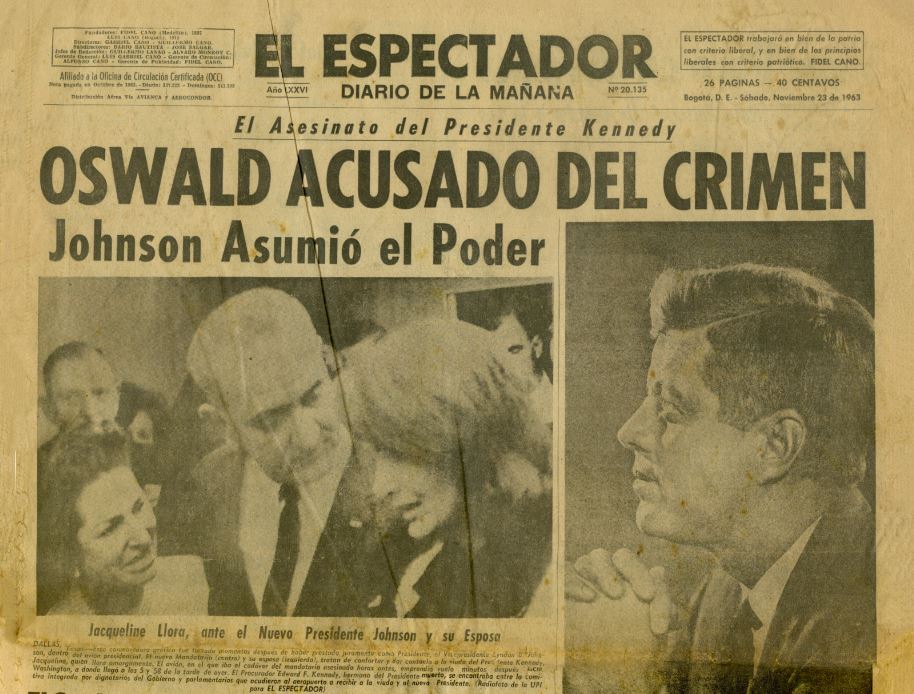
Headline in Colombian Newspaper on November 23, 1963. Friends of Colombia Collection, Peace Corps Community Archives.
Geer Wilcox learned about the assassination of John F. Kennedy’s while living in the Dominican Republic. As a blind Peace Corps Volunteer, Wilcox relied on hearing the news from neighbors reading newspapers and the radio. He often commented on the state of American politics or the Vietnam War as he listened to the international news broadcast, the Voice of America. When the news of Kennedy’s death broke, Wilcox reported feeling apprehensive of Lyndon Johnson and the future.
Wilcox expresses his shock in a recorded letter home to his parents on November 30, 1963:
Rene Cardenas was in Colombia when the news broke. She processes the aftermath of Kennedy’s death in a poem titled “Yesterday November.”
The address for sorrow
two inches away
the president has been killed
the clouds of wet season
the earth’s longest pity
everything is split time
a piece of wood
pulled apart at the grain
in an apartment in Cucuta
han asesinado a Kennedy
bells toll for three days
sent notes of condolences
to the wall
by my bed
two inches away
from my face.
Additional reactions to President Kennedy’s death are recorded here.
“What a sick society I left.” Assassination of Senator Robert Kennedy- June 6, 1968
Even as he served in Western Samoa, Arthur Aaronson wrote home often about the 1968 Democratic candidates Senator Robert Kennedy and Eugene McCarthy. He heard about the attack on Senator Kennedy from other PCVs and the radio, which gave details about what happened in the hotel kitchen of the Ambassador Hotel. Aaronson wrote to his parents that evening:
I heard the news about Kennedy Wed. night as I was walking back from a dance with my sister. Two volunteers walked by and they told me the news. I was stunned. Then when I heard it on the radio that night I could only cry as the radio gave the details. The death of Martin Luther King didn’t hit as hard. Probably because Kennedy was on the way to being the next President. All the wealth and power of the U.S., it does not hide the fact of what a sick society I left.
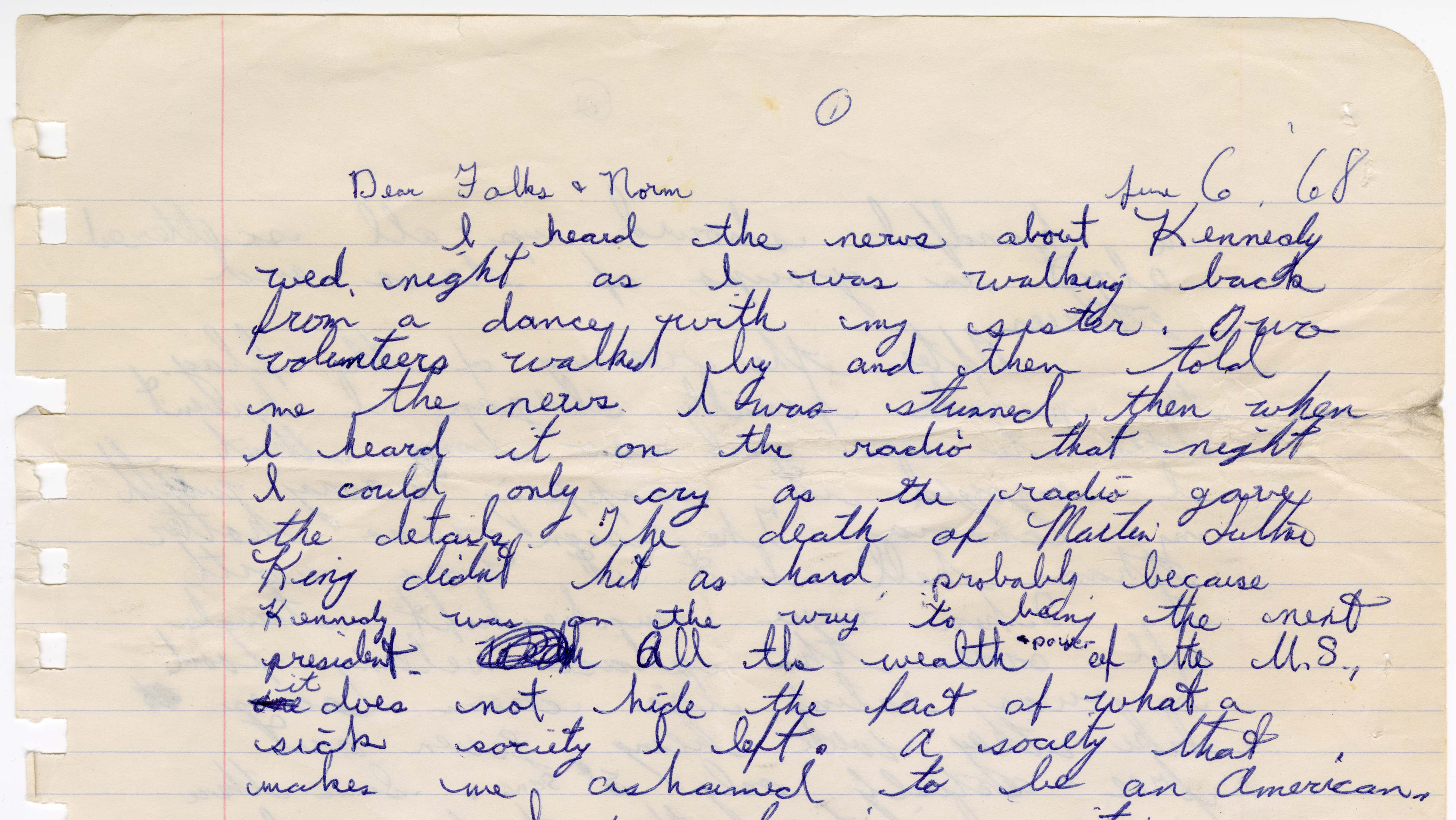
Aaronson’s letter home on June 6, 1968. Peace Corps Community Archives.
“I can only hope something good comes of all this.” Rodney King Riots- April 29, 1992

Photograph submitted by Dark Sevier on January 1, 2008. Flickr Creative Commons
In March 1991, a bystander recorded a video of four L.A. police officers beating Rodney King—a black motorist—for a reported 15 minutes as other LAPD officers looked on. Despite the video evidence, the court found the four officers “not guilty” of excessive use of force on April 29, 1992. Fueled by this acquittal and years of racial and economic inequality, riots broke out around South Los Angeles, raging for 5 days.[1]
Tina Singleton watched the riots transpire as she completed her volunteer staging in Cameroon. She had lived and worked in San Francisco for 10 years before joining the Peace Corps in 1992. Singleton followed the events and devoted several diary entries to her thoughts:
30 Avril 1992
Just heard about the 4 police officers in the Rodney King Case being acquitted—I was sad and in shock. I just don’t understand how the jury came to that conclusion—it blows me away—I’m so upset. It’s hard to concentrate on anything. I’ve had a few good cries. Also heard about the rioting in L.A.—it’s awful—but I understand the reaction. This was such a blatant disregard for justice and Rodney King’s civil rights—what a disgrace—and with all the evidence—a videotape and all the tapes of the officers’ conversations—and they still got off. Rose-Marie and Soyeon and I were/are very shaken by this. The U.S. is getting worse by the minute. It makes me not want to even go back to the U.S.—I’m happy I’m here for two yrs.
1 Mai 1992
It’s gotten worse—protesters are now in San Francisco, Atlanta, Dallas—they’ve blocked the Bay Bridge again. Can’t believe all this is happening—1992 and we’re having race riots. I can only hope something good comes of all this—the rioting, the looting—I almost wish I could pick up a phone and call Jean and Peggy. This was my first taste of what it’s going to be like when a serious situation arises in the U.S.—I felt pretty cut off. I see what volunteers mean when they say the shortwave will become your best friend. We listened to is as much as possible. What I wouldn’t do for a newspaper right now. This is the weekend we stay with a Cameroonian family—should be interesting. Though I’ve been upset and crying today about this Rodney King episode. I just can’t believe this has happened—It still blows my mind.
Lundi, 3 Mai 1992
Heard on the news this morning about L.A.—2,000 people hurt, 40 dead, Bush has declared L.A. a disaster area. I guess he’s going to LA this week to see the damage—don’t have figures on the other sites—saw the news this weekend on TV at my family. L.A. looks pretty bad—fires everywhere. Saw Rodney King—he was so upset. I felt so bad for him. He kept saying “it’s not right, this isn’t right—we only want our day in court.” He was pretty devastated about all the violence as well—he spoke about the people not being able to go home to their families. He looked so devastated—I felt so bad for him. He just looked so bad—so down. Like I said before—I hope something good comes of this.
5 May 1992
Well, last nite was a real shit nite. Sebastian brought newspapers from Dovala—A USA Today and some French language papers. I was not ready for what I saw—the pictures really floored me. I knew it was bad in LA, but I didn’t know how bad. The man [Reginald Denny] being dragged from his truck and shot—then robbed. The white man who was on the ground and being kicked by 3 Black men—it’s so sick. I’ve got such a bad headache. I can’t stop thinking about all this madness. This whole thing has me wondering why I’m here and not at home doing something to help the situation there.
It’s so hard to concentrate on my French—we’re here for only 2 more weeks. I am worried about my French—it doesn’t seem so important anymore. I hope I’m not going to feel like this for a long time—I know if I do, I’d leave, and I don’t think that’s what I want. I’m just so confused now. People here seem to think things will be better after this, but I don’t think so. I’m feeling pretty pessimistic at this point—I’ve no other reason to feel otherwise. Soyeon and I had a good cry last nite. We’re both in a daze, as is Rose-Marie. Heard on the news this A.M. that 10,000 businesses were lost as well as at least that many jobs—which is something we can’t afford to lose.
Soyeon and I are calling home tomorrow—I can’t wait. I really need to talk to the folks—I might call Jean too. I’m not sure—it will be great to at least talk to Mom and Dad. It’s sounds like Mom’s feeling a little lost with me gone. It’s weird for me not to be able to pick up the phone. I was dying to talk to them last night—tomorrow will come soon enough.
— T
As a Black woman who lived in California—or rather, anywhere in the United States—Singleton was shocked and devastated by reoccurring injustices in the United States. Cut off from her friends and family and relying only on news from the radio and infrequent newspapers, she found support from two other Black volunteers—Soyeon and Rose-Marie—to process the injustice of the trial and the impact of the riots.
Despite her initial desire to return home, Singleton spent 3 years in Benin, West Africa as a Health Educator. She became an international development worker for over 20 years and launched a program called Transformation Table, devoted to promote sharing a meal and culture between communities, in November 2016 in Charleston, SC.
“We shortly came to the realization that life had changed.” September 11, 2001
Living in a remote village in Zambia, Lara Weber was listening the the Voices of America when the voice over the radio reported, “”A… plane… has… hit… the… World… Trade… Center… in… New… York… City…” With no electricity, internet, or phone within a day’s drive, Weber explained feeling detached as more and more reports rolled in. She also worried about her father, who occasionally visited the Pentagon on business.
The weeks that followed were strange in that I had no Americans to talk with at all. Some of the elder men of the village visited me one day. They wanted to understand the news better, and their questions were interesting. One man wanted to know more about the Twin Towers and Manhattan. Why did so many people need to live and work on top of one another in such vertical spaces — had we run out of land in the rest of America? I tried to answer, but what I said felt inadequate and the whole idea of New York suddenly made no sense. Why did we pile into cities like that?
Rhett Power’s experience was a little different. As a volunteer in Uzbekistan, Power remembers a sense of confusion and urgency following the events, as the Peace Corps determined when to evacuate PCVs in the countries close to Afghanistan.
Power remembers sitting on the floor of a hotel room in the capital with his wife and a group of PCVs after a series of new volunteer training sessions. They were watching CNN when it happened. Power recalls the initial reaction:
I remember it distinctly. My wife and I were…Well, we were in the capital. So we were actually getting ready to go to the airport. I think a group had either come the night before or the day of. We were at a hotel. We were doing a Peace Corps training for new volunteers. There was another married couple there, they were education volunteers—I think he was a health volunteer—but anyway, we were together in the hotel. We were actually loving life because we were in a bed. A really good bed and we actually had two boxes of pizza on the floor. I think we had Orange Fanta and we were beside ourselves. The luxury of it all.
I distinctly remember this—we had a tiny little TV on CNN. You know, again we were watching TV. We didn’t have anything else to watch. But we had one international channel. And, that’s when it happened. And, we were watching it and just—we were just as shocked as everybody else was. I think [we] shortly came to the realization that life had changed. Because we all knew what would happen. Very shortly thereafter—within that hour we knew that something had changed and that something would change.
After three weeks, the Peace Corps evacuated Power and the other PCVs living in the Middle East and sent them back to the United States without reassignment.
As people back home find support within their communities, during times of tragedy PCVs find themselves relying on other Americans, throwing themselves into their work, or talking with their host communities about the implications of the event. Often, these tragedies lead to a renewed sense of faith in the mission of the Peace Corps—as seen in the uptick of Peace Corps applications in the wake of the Kennedy assassinations and 9/11. In other cases, such as the riots in L.A., it can be a reminder of how far we haven’t come.
Sarah Leister is an anthropology graduate student in Dr. Adrienne Pine’s Craft of Anthropology I course (ANTH-601). This blog post was written in fulfillment of a course assignment.
This blog post will analyze two items from the AU Archives associated with Margaret (Peggy) Gleeson’s volunteer services in the Peace Corps. Gleeson was a nurse who joined the Peace Corps in 1963, just two years after it was founded by President John F. Kennedy. She volunteered in a small village in Colombia called Fusagasugá, where she was tasked with teaching classes to Colombian nurses who worked at the local hospital. This post will focus on Gleeson’s Peace Corps training before she went to Colombia by analyzing two documents: the training manual and her biographical sketch. These documents highlight the political context of the Cold War and how Gleeson and her fellow volunteers felt about their upcoming Peace Corps service.
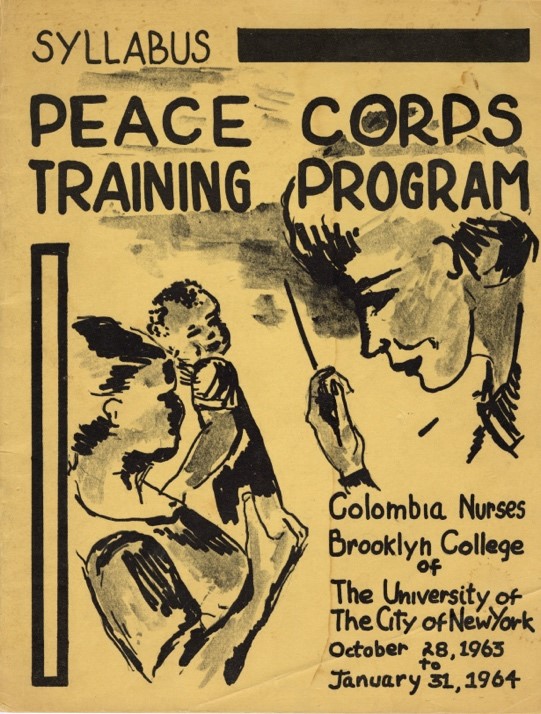
Gleeson’s Peace Corps training syllabus.
In the early 1960s, Cold War tensions were high. The Cuban Revolution had succeeded in 1959, and the 1961 CIA-led Bay of Pigs invasion that attempted to reverse it had failed. The U.S. aimed to prevent a supposed threat of communism in other Latin American countries. This imperial project coincided with updated Social Darwinist ideologies proposed by U.S. economist Walt Whitman Rostow that placed Latin American countries (and especially the indigenous communities within them) in an earlier stage of development and modernity than the United States (Geidel 2010).
It is against this political backdrop that Gleeson embarked upon an intensive Peace Corps training program in 1963 at Brooklyn College. She was a member of the first group of nurses to be sent to Colombia by the Peace Corps. According to the program’s syllabus, the training included courses on common diseases in Colombia, Colombian history, Spanish language, and ten sessions on “The Challenge of Communism.”
As I looked through the Peace Corps Training Program syllabus, I was surprised to see that Brooklyn College, rather than a U.S. governmental entity, was responsible for training the Peace Corps volunteers. Fernando Purcell and Marcelo Casals (2015) point to the crucial role of U.S. universities in offering training during the Cold War, which were known to give volunteers “theoretical and practical knowledge about modernity and community development, along with a reinforcement of ideological values that were defended during the Cold War” (2). The Brooklyn College syllabus includes readings by staunch anti-communist Zbigniew Brzezinski—an advisor to President and Peace Corps founder John F. Kennedy. It explicitly frames communism as a threat and focuses on the study of Soviet models while glossing over the “great variety of revolutionary models” in Latin America (Purcell and Casals 2015).
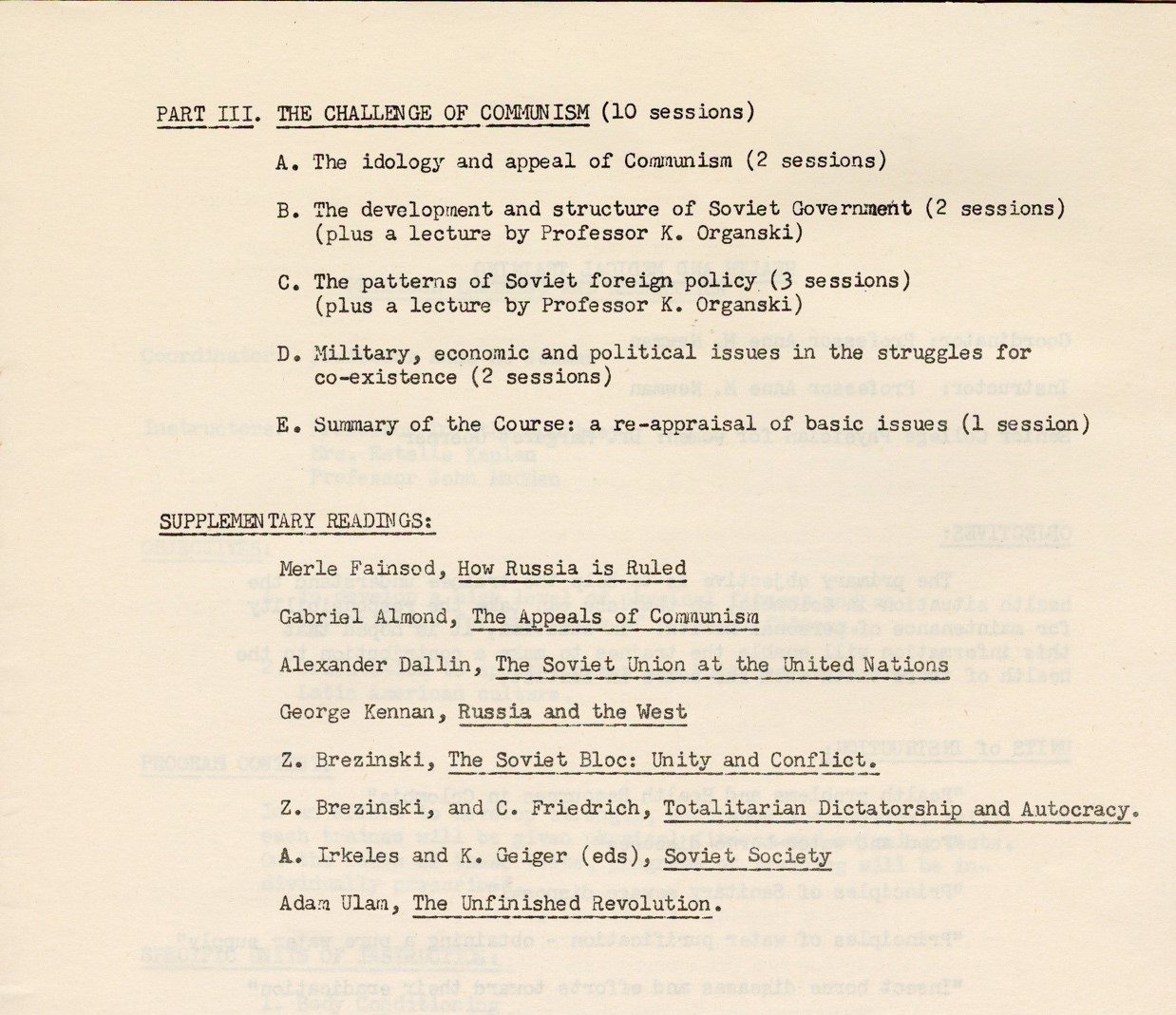
The communism section of the Peace Corps training syllabus.
Also in the syllabus, a letter to the volunteers from the Office of the Mayor of New York City states “We in New York City are proud that one of our great municipal institutions is becoming part of the world-wide efforts of the Peace Corps to help the underprivileged peoples of the world.” Similarly, most of the volunteers in Gleeson’s training group stated that their reason for joining the Peace Corps stemmed from a desire to help or serve others.

Gleeson’s biographical sketch featured in a booklet of volunteers’ biographical information.
These documents show an interesting parallel between the U.S. government’s battle against perceived communist threats and the volunteers’ desires to help. They also shine light on the ways in which volunteering, aid efforts, and even social science research have coincided with U.S. imperialism, despite volunteers’ and researchers’ good intentions. While Gleeson and many other Peace Corps volunteers went abroad with a desire to be helpful, a consideration of the broader political context might evoke the title sentiment of Ivan Illich’s provocative speech given to a group of U.S. volunteers in Mexico in 1968: “To Hell with Good Intentions.”
As a white anthropology student from the U.S. who has also traveled to Latin America with good intentions, I am in many ways similar to Peggy Gleeson and other Peace Corps volunteers. This leads me to ask, how can U.S. students, volunteers, and workers analyze their individual intentions within structures of power? To what extent do our intentions matter? How can we make our intentions match up with our actions? How can we combine our intentions and actions in pursuit of international solidarity and social justice, rather than as charity that ultimately reinforces empire?
Even as we move into November, I would like to return to October. Many may know it as a month of horror movies, candy, and spooky decorations, but it also happens to be Lesbian, Gay, Bisexual, and Transgender History month.
I originally intended to highlight stories about LGBT+ volunteers serving in the Peace Corps—the only issue is that donors do not usually disclose their sexual orientation or gender identity when offering their materials to the PCCA. However, we do have some items related to heterosexual couples and marriage during Peace Corps service. You can view the corresponding blogs here and here.
Since the PCCA is home to personal collections for over 200 Returned Peace Corps Volunteers (RCPVs), I have reason to believe that at least a few identify within the LGBT+ community. Yet, even if I were to find traces of homosexuality or transgender experiences, it feels unethical to disclose personal information without the donor’s permission.
That said, I poked around online and found quite a few Peace Corps groups that offered guidance and support to LGBT+ volunteers, as well as blog posts written by LGBT RPCVs.

The Princess Diaries 2: Royal Engagement, 2004.
In this belated LGBT+ history month post, I want to formally request Lesbian, Gay, Bisexual, Transgender, Queer, and Asexual RPCVs (From 1961 to present-day) to consider donating their materials to the PCCA so that we can represent a vast array of PCV experiences.
I would also like to emphasize the incredible work of Jim Kelly and the Lesbian, Gay, Bisexual, Transgender Returned Peace Corps Volunteer Association, while touching on the milestones of LGBT+ Peace Corps history.
In many countries around the world, identifying openly (or “coming out of the closet”) as gay, lesbian, bisexual, or transgender is illegal. In others—including the United States— LGBT+ continue to face discrimination, violence, and even death. Those who appear to fit into the heterosexual societal expectations of gender and sexuality incur the trauma of loneliness and shame from the lack of recognition and acceptance for who they are. LGBT+ Peace Corps Volunteers often have to choose between the call to “promote world peace and friendship” and their own mental or physical health.
When Kennedy created the Peace Corps in 1961, the organization’s stance on homosexuality corresponded with that of the United States federal government. During the 1950s and ‘60s, the United States collectively feared Communist spies. Government agencies rooted out potential security breaches, focusing largely on anyone suspected of being a homosexual.
In this cultural environment, RCPV Jim Kelly applied for the Peace Corps. Kelly recounts the application process and facing the survey question: “Are you a homosexual?”
For a young gay man in the 1960s, his only option was to commit perjury—and convince all of his friends to lie as well. While he enjoyed his service in El Salvador, Kelly mentioned feeling anxious of discovery and lonely for a community supportive of his true self.
Listen to Kelly’s 2017 interview at OUTSpoken in Chicago:
Fast forward to 1992, Kelly completed a master’s thesis called “Hidden dimensions of diversity: gays and lesbians in the Peace Corps,” where he interviewed 80 RPCVs and recommended widespread institutional changes to the Peace Corps. Kelly’s study was foundational to initiating worldwide conversations around sexual orientation and gender identity within the organization.
The National Peace Corps Association currently encourages LGBT+ applicants and same-sex couples to serve abroad. Considerably more resources and support systems are available to volunteers during their time overseas, however individual experiences vary depending on the person and social climate of the country. Presently, the Peace Corps reports 18 countries with medical clearances to support HIV+ volunteers and allows applicants to choose specific countries of service.
Do you identify as a LGBTQ+ Peace Corps Volunteer? The PCCA is interested in preserving your materials and understanding how your identities shaped your service. We accept both digital and physical blogs, journals, correspondence, videos, photographs, training materials, and more! Reach out to us at archives@american.edu.
What did you do last month? Associate archivist Leslie Nellis, American University library consultant Robert Newlen, and I took the archives on the road for the opening festival at the REACH building of the Kennedy Center. The event was a collaboration between the National Peace Corps Association (NPCA), the Returned Peace Corps Volunteers of Washington, DC (RCPV/W), and the REACH.
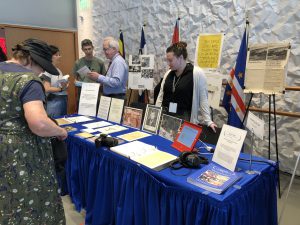
Robert Newlen (left) and Leslie Nellis (right) speak with visitors about the Archives, September 22, 2019
In a room known the Peace Corps Place, PCCA launched “Answering the Call” –a temporary exhibit highlighting RCPVs experiences using their donated materials. Sixteen other exhibitors joined us, including booths by the Peace Corps Oral History Project and the Museum of the Peace Corps Experience.
We spent the day greeting visitors and describing our efforts to collect, preserve, and make available the materials donated by RPCVs. Close to 300 visitors—many of them RPCVs with their families—flipped through examples from the current collections, listened to Geer Wilcox’s recorded letters sent home, and shared their own memories of their time in the Peace Corps.
Packing lists from the ‘80s spurred conversations between old and new RCPVs about what has changed and what has not. One woman laughed and said “They told me to pack a meat-grinder.” Others snapped photos of President John F. Kennedy’s 1961 letter to volunteers or the poster that read “She taught me how to write my name, I taught her how to say it.”
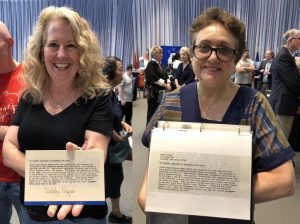
RCPV woman (left) and Debby Prigal (right) pose with Prigal’s donation.
About halfway through the day, RPCV Debby Prigal discovered her own donated materials within the exhibit and reproduced on free postcards. “That’s me! That’s mine!” She exclaimed, pointing at her entry in the copy of a “Close of Service” Newsletter. For a moment, Debby achieved celebrity status as others asked for her to autograph their postcards.
The entire day was a perfect example of PCCA’s goals to enrich the Archives through partnerships with Peace Corps affiliates, exhibit materials that document the impact of individuals who volunteered, increase the awareness of the history of the Peace Corps, and of course, make some new friends!
If you or someone you know is interested in finding out more about donating to the collection, please visit the “Donate” tab or email us at archives@american.edu.
On March 1, 1961 President Kennedy signed an executive order establishing the Peace Corps. He asked Americans how many of them would be willing to serve their country and the cause of peace by living and working in the developing world. Thousands answered the call in 1961 and 750 were chosen to serve in 13 nations.
Throughout the summer of 1961 volunteers took tests for selection and were trained for service.
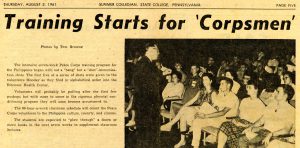
By the end of the summer groups had already begun serving, the first groups went to Ghana and Colombia, or were preparing to leave.
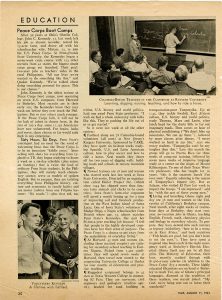

As volunteers were preparing to leave they were given travel itineraries, packing tips, and even guidelines for dealing with the press. Along with formal congratulation letters from Governors and Senators, volunteers were also featured in local newspapers.
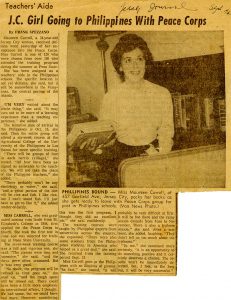
Once training was over and all the packing was done, volunteers were sent on to their designated countries. The first groups served from 1961 to 1963.


Maureen Carroll served in the Philippines from 1961-1963 in Education.
After two years of service, they were all welcomed home.

While some things have changed since 1961, the life of a volunteer is still very much the same with training and living abroad. 58 years later the Peace Corps is still meeting Kennedy’s challenge of serving the U.S. and the cause of peace.
Every year, to celebrate this anniversary, the Peace Corps holds Peace Corp Week which “celebrates all the ways that Peace Corps makes a difference at home and abroad and renews its commitment to service.”
This year, Peace Corps Week is February 25 – March 3 and the theme is “Highlighting Home: What does home, family, and community look like in your Peace Corps country?” You can attend a Peace Corps event near you or vote for the best video in the Video Challenge.
Before leaving for a foreign country, Peace Corps Volunteers in the 1960s were required to complete intensive training to help prepare them for their experiences abroad. This training occurred at universities all over the United States. They learned a variety of tasks ranging from agriculture and livestock care to language studies. Each PCVs’ training varied by where they attended training, their service type, and other factors.
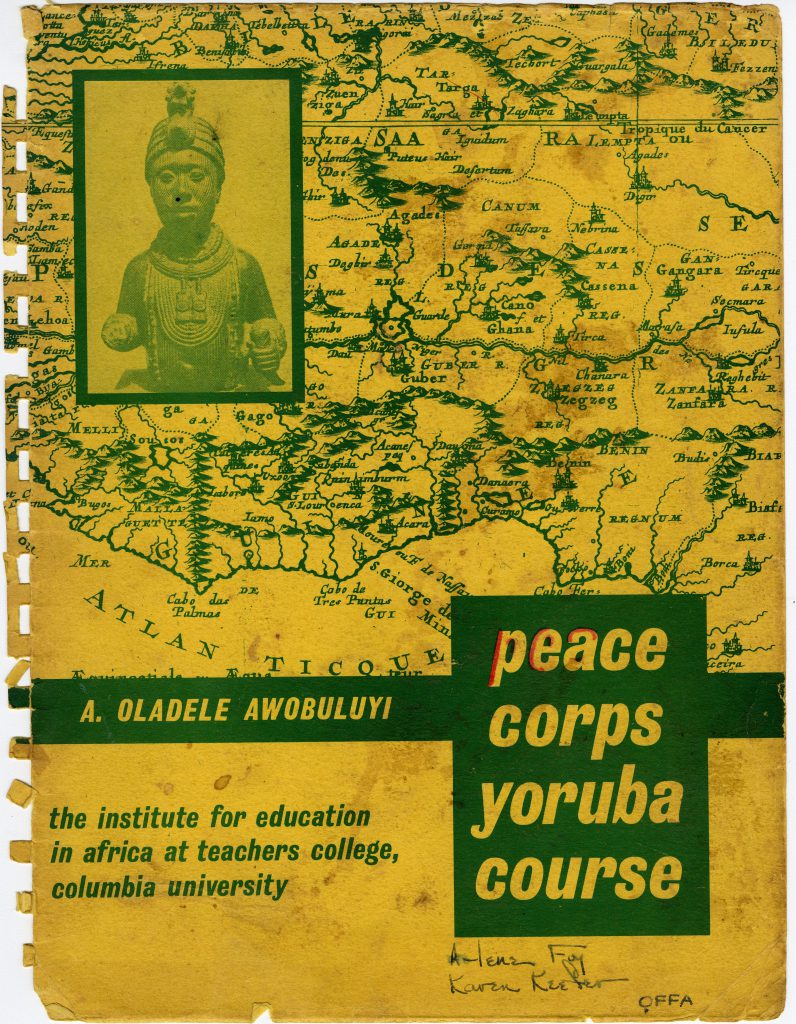
Peace Corps Volunteers all received informational packets on their training, much like this one from Karen Keefer who trained at Columbia University for her service in education in Nigeria.
One of the earlier PCVs is Thomas Hebert, who trained at University of California, Los Angeles in June of 1962. Hebert served in Nigeria from 1962 to 1964 educating youth and managing the University of Ibadan’s Shakespeare Traveling Theatre program. Hebert spent a total of 419 hours training for his service in Africa. The bulk of his training program was an orientation on Africa and Nigeria, totaling 92 hours, where he learned how to effectively communicate and understand the culture he would be serving in. Interestingly enough, Hebert also had a total of 81 hours of training in American Civilization and Institutions, which would “[enable] the volunteers to see political events more perceptively, to view the interchange of political interests more realistically, and to articulate democratic values more convincingly,” according to the training informational packet.
Hebert also spent 60 hours learning educational practices for Nigeria, in order to understand how to effectively reach his students abroad. He also had 55 hours of training in the languages of Hausa, Ibo, and Yoruba, the three major indigenous languages of Nigeria. In addition to his practical training, Hebert also spent 43 hours on health training and 56 hours in physical education. The Peace Corps emphasized the importance of each PCV’s health during their service. Lastly, he also spent 32 hours on “Special Features,” which ranged from lectures to documentaries.
Winifred Boge attended training at University of California, Davis from February to May 1965. The program totaled 720 hours of work over a 12-week period, resulting in an average of 60 hours per week. Boge served on the Health Nutrition Project in India, but her training also covered a variety of topics to assist with her transition into life in a different country.
For Boge, the most time was spent on language training, with a total of 300 hours on learning Telugu. Next, she focused on technical studies on health and nutrition, for a total of 200 hours. Following this, she also learned area studies and world affairs for 105 hours in order to understand the history and culture of her place of service. Also required for training was physical education as well as health and hygiene to ensure the health of every PCV.
One of the more interesting areas of study is the topic of Communism for 15 hours total. While each area of study in the information packet includes a description and list of teachers, Communism lacks this information. Even though the Red Scare of the 1950s had passed, the Peace Corps probably wanted to prepare their PCVs for different types of government in the world.
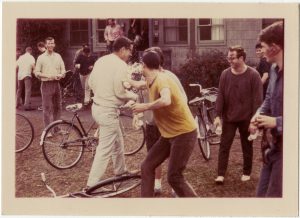
Many Volunteers enjoyed their training because it gave them a chance to get to know fellow PCVs. Pictured here by Boge, PCVs interact during their training at UC Davis.
Peggy Gleeson Wyllie trained at Brooklyn College from 1963-1964 for her time as a nurse in Colombia. She spent most of her time–a total of 360 hours–in intensive language studies in Spanish. Not surprisingly, the second highest element of training at 106 hours was technical studies, along with 30 hours of health education. Technical studies included techniques in Nursing as well as the prevention and treatment of diseases found in Colombia. Wyllie also spent 72 hours learning the history and culture of Colombia, as well as 60 hours studying American studies, world affairs, and Communism. Like Boge, Wyllie learned “critical appraisal of the developing concepts and organizational challenges of the Communist world.” Lastly, she attended classes in physical training for 72 hours and a general “Peace Corps Orientation” for 20 hours.

After completion of their training, many PCVs received a certificate like this one. Steve Bossi completed his training in conducting Science Workshops in India from University of Wisconsin, Milwaukee.
Each training session, no matter how different in terms of location of training, location of service, or service type, served to best prepare each PCV for the challenges and successes they experienced during their service. Training takes into account the culture and society each PCV is entering in order to provide guidance for the most effective approaches to help both the Volunteer and community alike.
Alongside the annual conference of the National Peace Corps Association held in Washington, D.C. in September 2016, AU Archives and Special Collections is debuting two exhibits highlighting its Peace Corps Community Archive. One exhibit will be a physical exhibit on campus and the other online.
The Peace Corps through the Lens of its Volunteers will be on display through the end of the semester on the third floor of the Bender Library.
The Peace Corps and Its Volunteers, the online companion exhibit, will go live this Friday August 26.
Both exhibits draw from the Peace Corps Community Archive and showcase the experiences of Peace Corp Volunteers through journals, letters, and photographs from the 1960s to the present.
For more information, please visit the Peace Corps Community Archive website. To use the collections or make a donation, please contact the AU Archives at archives [at] american.edu.
Many Returned Peace Corp Volunteers recognize the value in preserving their experiences. Currently, the Peace Corps Community Archive has over 50 donors, but other volunteers, like Doug and Kate Hall, have created their own related collections.
Doug and Kate served in the Peace Corps from 1968 – 1969 and were stationed in Kathmandu, Nepal. They met during their Peace Corps training and were married in 1972, after their Peace Corps service. In the last few years, they have pushed for a collective effort from Nepal’s volunteers to digitize and catalog photographs taken between the years 1962 – 1975. Titled the PC Nepal Photo Project 1962-1975, the collection currently has over 90 contributors and 12,500 photographs.
According to Doug, the project does not emphasize the Peace Corps experience, but rather focuses on life in Nepal from 1962 – 1975. Specially, the images highlight Nepali life outside the Kathmandu Valley.
While libraries and archives in Kathmandu have photos from the 1930s, these are almost exclusively from the Kathmandu Valley. Peace Corps volunteers were mostly posted in towns and villages where no Nepali had a camera. Thus, these early photos are among the first ever taken in many regions of the country.
The photograph’s being collected represent a range of Nepali life. They span regions and lifestyles, from agriculture and rural schools to coronations and urban architecture.
In addition to the online collection which uses Adobe Lightroom, Hall has created a Facebook page that highlights the images by theme. Both are fantastic resources for researchers. Hall reports that once the project is complete he will share copies with 3 national libraries and archives in Nepal.
To donate to the PC Nepal Photo Project 1962-1975 please contact Doug Hall, doughallnh [at] comcast.net.

John Hughes submission
Date: 1971
Location: Shani-Arjun, Jhapa
Description: A rural scene in Parakhopi. The man is an Indian sadhu.

Carl Hosticka submission
Date: 1967
Location: Gulmi
Description: A wedding party. The sounds of the band echo across the valleys and can be heard for miles.

Carl Hosticka submission
Date: 1966-07-14
Location: Majhuwa, Gulmi
Description: One of a series of pictures depicting rice cultivation.The field is partially flooded and the plowing is continued.

David Carlson submission
Date: 1964-1965
Location: Baglung, Baglung
Description: Women wash themselves and clothing in the sacred waters of the Kali Gandak as part of the Dashain festival.

Diane Wishinski submission
Date: 1964
Location: Kathmandu, Kathmandu
Description: Tibetans hand-weaving rugs.

Hank Lacy submission
Date: 1968
Location: Baglung, Baglung
Description: Women cross a crude suspension bridge across the Kali Gandaki River, near Baglung, with heavy loads of firewood.

Bob Nichols submission
Date: 1972
Location: Kathmandu, Kathmandu
Description: Gaun Panchayat banner at a holiday event

Bob Nichols submission
Date: 1968-04
Location: Solukhumbu
Description: Girl in field. Picture may be at the Lukla airstrip. Rock fence row in the background.

Jim Coleman submission
Date: 1973
Location: Bhaktapur, Bhaktapur
Description: Red peppers spread out to dry on mats in a street

Stu Ullmann submission
Date: 1964-01
Location: Pokhara, Kaski
Description: Residents of Pokhara and nearby villages coming to the Seti Gandaki at Ram Ghat for ritual bathing during the Magh Mela. This view is from the east side looking west at the point where the Seti Gandaki emerges from a deep gorge and widens out (Ram Ghat).

Mike Gill and Barbara Butterworth submission
Date: 1978-12
Location: Sindhuli
Description: Porters carrying empty kerosene cans in the riverbed of the Sun Koshi.

Gerard Oicles submission
Date: 1969-1971
Location: Siraha
Description: Group of women pressing and flattening marijuana (ganja). Ganja was the most important cash crop in the district. The price of finished ganja was 12 rupees per kilo in the local market. By the time it hit Europe, it was $120/kilo and had been cut.

Rick Pfau submission
Date: 1975-02
Location: Kathmandu, Kathmandu
Description: Preparations for the coronation of King Birendra.

Larry Daloz submission
Date: 1964-05
Location: Bhojpur, Bhojpur
Description: Gold and silversmiths sell gold ear and noserings, silver wrist and anklets. Clearly, paper money was much used at this time, though notice the necklace of old Indian rupees that was still a staple of women’s clothing, showing off to the community women’s value.
Earlier this month, the Peace Corps announced it would partner with Michelle Obama to expand educational opportunities for women around the world. This partnership plans to accomplish this goal through specialized community training, raising public awareness and support for international partnership programs, and recruiting and training hundreds of new Peace Corps Volunteers working to serve as advocates for female education.
The Peace Corps Community Archive’s holdings reflect the Peace Corps’ continuing commitment to promote female education. From 1968-1970, Christine Hager served in Colombia working as a community developer. Part of her duties included educating women about self-sustainable work such as cooking and sewing. Winifred Boge worked on the Health Nutrition Project from 1965-1967, which educated men and women in India about healthy daily practices. The more recently announced initiative by Michelle Obama and the Peace Corps will build upon the already impressive work of the Peace Corps in addressing the need for increased female educational opportunities throughout the world.